Thor son of Odin wears it best. Posted by hulda on Nov 30, 2013 in Icelandic culture, Icelandic history
“What’s the most typical syllable that names begin in Medieval, Norwegian sagas?” our professor asked on our this week’s Medieval literature lesson. People guessed immediately Þór/Þor, which was actually not correct for Norway but rather Iceland. If you’ve ever read Icelandic sagas you’ll totally understand this one… it’s almost comical to try to follow the story when everyone in it is called Þor-something.
Things still haven’t changed much in this regard. A quick look at the Nöfn Íslendinga shows 129 names in total that begin with either Þor- or Þór-, of which 69 are women’s names. That’s more than 50% folks! What makes this even more interesting is that it bears the meaning “strong” or “Thor”, which is obviously seen as an equally wonderful beginning of a name for both men and women. Or perhaps Þór simply was the most popular god of the æsir here in Iceland and that it sort of stuck in the culture of naming people and places, who knows.
Þór goes fishing with the jötunn Hymir. The planned catch is none other than the Miðgarðsormur himself, and the bait is a head of Hymir’s ox.
What was the real Þór like, then? One thing is for certain, he was very much unlike the Marvel comics Thor or the Thor of the recent movies. To begin with Loki was not his adoptive brother, not even an uncle although some people like to make the connection from Loki and Óðinn, Þór’s father, being blood brothers. The vows did not extend the relationship, however, being a bloodbrother to someone meant a bond only between those who tied it and it had zero effect on their families. This is why Óðinn could not avenge the death of his other son Baldur to Loki but the other gods could: Óðinn was the only one of them who had made a promise of eternal brotherhood with him. Þór played a large part in both catching and punishing Loki, in fact.
Þór owned a dwarf-made hammer, Mjölnir (= A smashing item, thing for smashing), that was otherwise quite an amazing weapon but it came with a huge flaw as well. Loki had bothered the dwarf-smiths while they were making it so that it ended up having a too short shaft. Because of this Þór needed iron gloves called Járngreipr (= iron grips) to be able to wield it; the hammer always returned to his hand but due to the short shaft it had to be used single-handedly, which seems to have been potentially damaging to even godly hands. Aside of this Þór also wore megingjörð/-gjarðir (= might-belt/s) around his waist that doubled his natural power. Besides all these things he’s also known for once dressing up as a woman.
Sif: “And is Freyja planning to get married?”
Loki: “What do you think? She didn’t want to!”
Þór: “That girlie listens to no reason, she just threw us down the stairs!!” (stúlkukind = a way of saying girl/lass, possibly a stubborn one, does not have a derogatory meaning)
As far as looks go the real Þór had red hair and a beard, which was mentioned specifically in Þrymskviða, the famous story of that one time Mjölnir was stolen. The æsir sent Loki in a bird coat to ask the thief, Þrymr, on what conditions would he return it. Þrymr demanded Freyja’s hand in marriage, which posed quite a problem because when Freyja was told of it she became formidably angry, shaking the very ground with her rage, and the æsir could not force her (or simply didn’t dare to try to).
“Þá kvað það Heimdallur,
hvítastur ása:
Bindum vér Þór þá
brúðar líni,
hafi hann ið mikla
men Brísinga.”
“Then said Heimdallur,
the whitest ás:*
We shall dress Þór, then
in a wedding dress,
give him the mighty
Brisingamen.”**
*White here most likely refers to either the colour of his clothes or his hair, as was typical in Old Norse texts. A man called “black” for example simply had black hair.
**Freyja’s necklace that she bought from four dwarf smiths by spending a night with each one of them. It was said to be the most beautiful necklace in the world.
Þór being dressed up for the wedding. The woman on the left is handing him Brisingamen, the necklace of the Brisingas, Freyja’s greatest treasure and her most typical symbol. The woman on the right is hanging a bunch of keys at his waist, a sign of a mighty Nordic woman. Freyja’s two cats look on and Loki in the back seems to be a little too amused…
Þór was not happy about this, of course.
“Þá kvað það Þór,
þrúðugur ás:
Mig munu æsir
argan*** kalla
ef eg bindast læt
brúðar líni.”
“Then said Þór,
the strong ás:
Æsir will
call me gay
if I let dress myself
in a wedding dress.”
***Ergi, as a word, translates in multiple ways that all mean unmanly. In this context it seems to have a very specific meaning since it’s tied to wearing a woman’s clothes, which in some sagas has been linked to homosexual behaviour. In Njáll’s saga, to mention one, Skarphéðinn throws a pair of ladies’ underwear at Flósi and tells him they’ll make his real pretty for the troll that he sleeps with “and who you let make a woman out of you”.
The situation was dire, though, since Mjölnir was the main weapon the æsir had against their enemies. In the very next sentence Loki says: “Aw shut up Þór, we’ll have the jötunns here in Ásgarð in no time if you don’t get your hammer back” (Þegi þú, Þór, þeirra orða. Þegar munu jötnar Ásgarð búa nema þú þinn hamar þér um heimtir).
Once Þór was dressed up Loki suggested that he should dress up as a female slave and follow along! This was actually the smartest idea of the whole story, because you can put Þór in a pretty dress and a veil but he’ll still be Þór-ish in behaviour. At the wedding feast he ate a whole oxen, eight salmons and drank everything that was put within his reach. Þrymr got suspicious but Loki, who in this part of the Þrymskviða is referred to as “alsnotra ambátt” (wise slave-girl), hurried to explain that “Freyja” had been awaiting the wedding so eagerly that she hadn’t eaten for eight days.
Well, that’s just endearing.
“Laut und línu,
lysti að kyssa,
en hann utan stökk
endlangan sal:
Hví eru öndótt
augu Freyju?
Þykir mér úr augum
eldur um brenna.”
“(Þrymr) Bowed under veil,
wished to kiss (Þór),
but he sprung out****
and along the room:
Why so fierce are
Freyja’s eyes?
I thought out of the eyes
fire was flaming.”
****This seems to hint that the bridal veil covered the whole face, and that Þrymr got his first glimpse of his bride-to-be’s eyes by lifting the veil. This shocked him so much that he literally bolted away from his bride.
Thankfully “the wise slave-girl” was again quick to point out that Freyja was so eager to be married to Þrymr that she also couldn’t sleep for eight nights, that’s why her eyes were blood-shot.
Next was time to tie the knot! This was when it came out that Þrymr never had any plan of ever letting the æsir have Mjölnir back: his logic was that once he’s married to one of them (though Freyja is actually one of vanir, another race, sent to live in Ásgarð as a hostage after a long war between the æsir and the vanir) he would keep his word by giving the hammer to Freyja instead. Brilliant plan, might have worked except that it would have needed Freyja to be the real Freyja and not Þór himself. What follows the moment he gets the hammer back is a bloodpath that spares no one in the room, least of all Þrymr whom he makes sure to kill first. Feels a bit like he had an axe to grind.
“Svo kom Óðins sonur
endur að hamri.”
“And that is how Óðinn’s son
got his hammer back.”
The end!

Build vocabulary, practice pronunciation, and more with Transparent Language Online. Available anytime, anywhere, on any device.
About the Author: hulda
Hi, I'm Hulda, originally Finnish but now living in the suburbs of Reykjavík. I'm here to help you in any way I can if you're considering learning Icelandic. Nice to meet you!



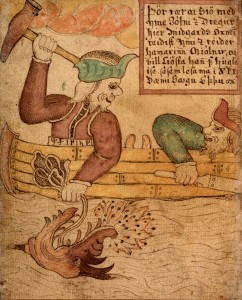
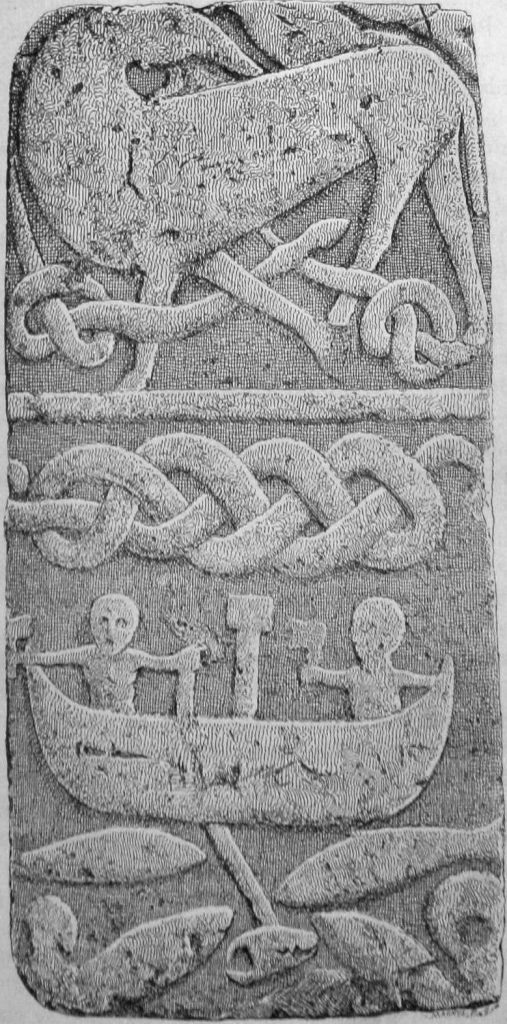
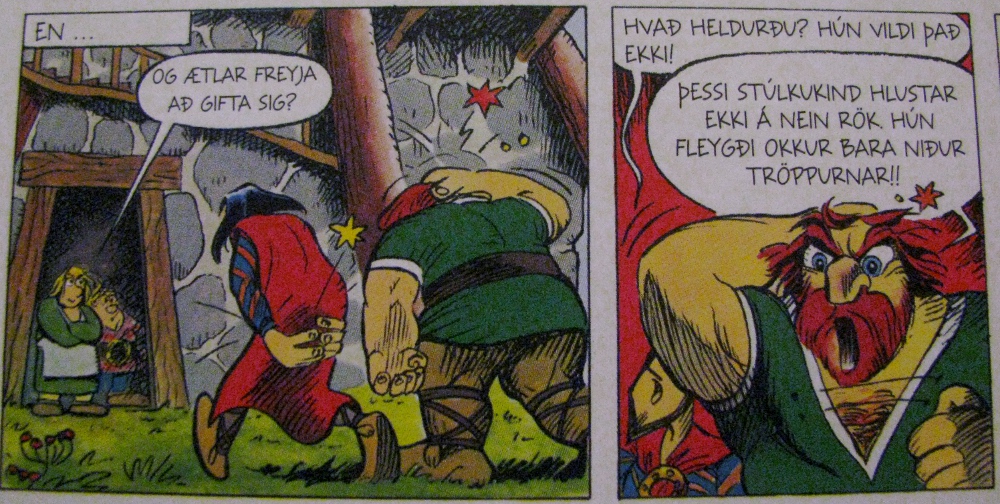
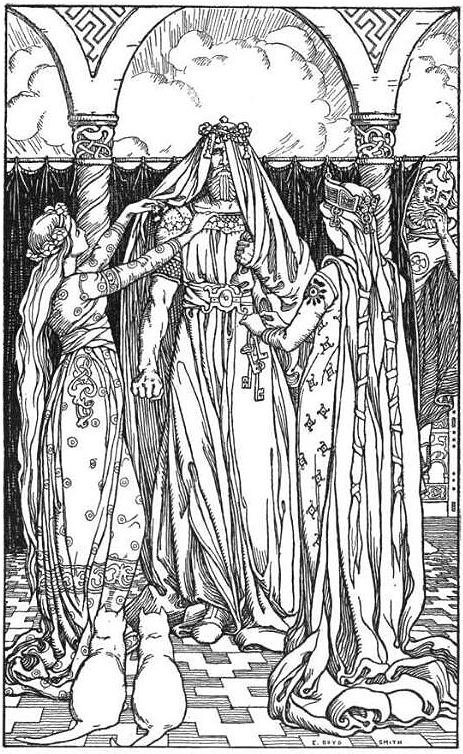
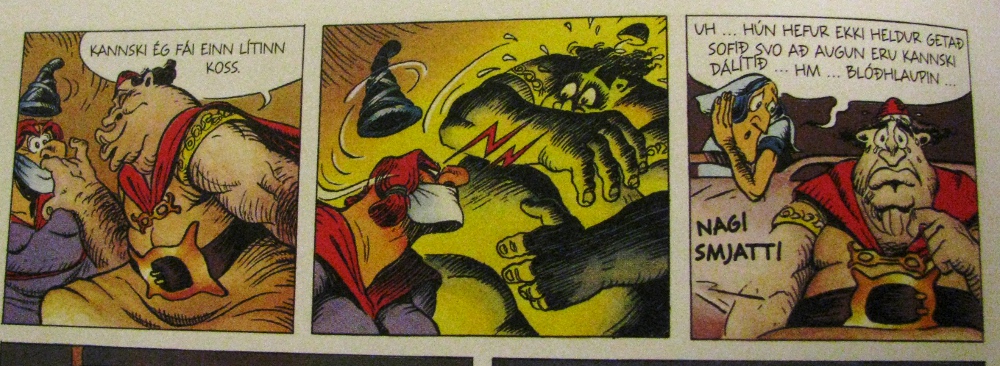

Comments:
Corin:
Hi Hulda,
Thanks for the post – where do the comic panels come from? Are there other stories in this format and are they still in print?
cheers corin
hulda:
@Corin Yes, they’re still in print! It’s a Danish series called Valhalla, consisting of in total 15 books that follow very closely the original myths. There are some changes of course (Loki’s punishment would not make a very amusing comic unless the reader likes horror). 🙂
There’s also one animated movie made out of the series, and having watched it I’d say it’s rather good!
Here’s two links that might help you in finding the books. I know that at least three of them are translated in English.
http://en.wikipedia.org/wiki/Valhalla_(comics)
http://www.valhalla-comics.dk/index.html
Brian:
So what IS the most typical syllable for the beginning of names in the Norwegian sagas?
hulda:
@Brian I think it was Há-. 🙂